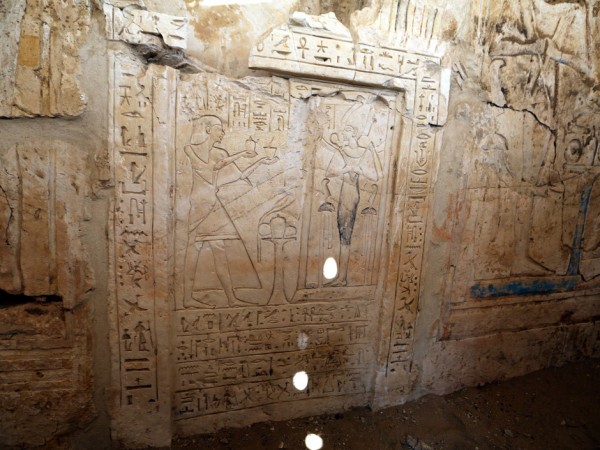Egyptians Discover Tomb of World's First Diplomat
| Robert Sarkanen | | May 09, 2014 08:54 AM EDT |
Historic inscriptions detail the Egyptian afterlife
Overview of the dig in Saqqara.
Egypt's Antiquities Minister, Mohamed Ibrahim, announced Thursday the discovery of a new tomb that is believed to be that of the world's first diplomat.
Archaeologists from Cairo University accidentally came across the 3,100 year-old tombs of two senior military leaders in the Saqqara necropolis, south of Cairo.
Like Us on Facebook
One of which they believe to be the tomb of Paser, the royal emissary to foreign nations and head of army archives during the late Ramesside period of the New Kingdom of Egypt.
Paser was sent to represent the pharaoh in foreign nations and is believed to have served under Seti I and/or Ramses II, one of the best known pharaohs of the New Kingdom.
The tomb, made of limestone, is modeled after a combination of both a temple and tomb, including a porch entrance supported by columns, a hall of pillars and an enclosed courtyard containing the burial shaft in the center.
It contains well-preserved reliefs, some with chips of paint remaining, revealing the colourful illustrations of Egyptian burial tradition.
Another sculpture shows Paser's funeral procession with his wife crying for her deceased husband, dispelling the long standing myth of excess reverence for the power of death in Ancient Egypt.
Also included is a detailed depiction of the Egyptian afterlife, with the Egyptian god Osiris welcoming the dead to the afterlife.
However, the tomb appears unfinished suggesting that Paser may have died at an early age during its construction.
The second tomb, all of which remaining is mud brick as the stone work has disappeared, belonged to army chief and treasury head Ptahmes, under pharaoh Seti I and Ramses II.
As one of the high officers of Ramses II's armies, Ptahmes was most likely a skilled commander and war hero, given Ramses II's numerous combat victories.
The close proximity of the two contemporary tombs suggests that Ptahmes and Paser may have been related or have had an otherwise close relationship.
The latter tomb was already known to archaeologists, with artifacts found already in the 19th century and grave robbers having emptied most of the contents in antiquity, but the excavation of the tomb itself started only 3 years ago.
These discoveries are held in great esteem by local authorities, since the find suggests that even though during the New Kingdom, the distant Luxor had taken the place of state capital from the nearby Memphis, Saqqara remained as an important burial site for high officials.
Authorities also hope the coming renovation of the tombs will attract greater number of tourists to the country, following the sudden sharp drop after the 2011 uprising in Egypt that toppled autocrat Hosni Mubarak.
The discovery of Paser's tomb in particular is hailed as one of great importance, giving archaeologists new insights into how Ancient Egypt saw its foreign relations, if they honored their emissary to such a great extent.
Combined with the startling architectural features, the tomb of Paser also suggests it was the product of a new architect previously unknown to Egyptologists.
The Saqqara necropolis is a well-known vast ancient burial ground initially used for the rulers of the Middle Kingdom of Egypt and the capital Memphis.
The necropolis features the pyramids of 17 different pharaohs and numerous tombs of high officials.
TagsEgypt, Ancient Egypt, Tomb, Military leader, Pharaoh, Ramses II, Archaeology, Saqqara, Paser, Ptahmes, Diplomat, Memphis, Luxor, Hieroglyphs, Osiris
©2015 Chinatopix All rights reserved. Do not reproduce without permission
EDITOR'S PICKS
-

Did the Trump administration just announce plans for a trade war with ‘hostile’ China and Russia?
-

US Senate passes Taiwan travel bill slammed by China
-

As Yan Sihong’s family grieves, here are other Chinese students who went missing abroad. Some have never been found
-

Beijing blasts Western critics who ‘smear China’ with the term sharp power
-

China Envoy Seeks to Defuse Tensions With U.S. as a Trade War Brews
-

Singapore's Deputy PM Provides Bitcoin Vote of Confidence Amid China's Blanket Bans
-

China warns investors over risks in overseas virtual currency trading
-

Chinese government most trustworthy: survey
-

Kashima Antlers On Course For Back-To-Back Titles
MOST POPULAR
LATEST NEWS
Zhou Yongkang: China's Former Security Chief Sentenced to Life in Prison

China's former Chief of the Ministry of Public Security, Zhou Yongkang, has been given a life sentence after he was found guilty of abusing his office, bribery and deliberately ... Full Article
TRENDING STORY

China Pork Prices Expected to Stabilize As The Supplies Recover

Elephone P9000 Smartphone is now on Sale on Amazon India

There's a Big Chance Cliffhangers Won't Still Be Resolved When Grey's Anatomy Season 13 Returns

Supreme Court Ruled on Samsung vs Apple Dispute for Patent Infringement

Microsoft Surface Pro 5 Rumors and Release Date: What is the Latest?











